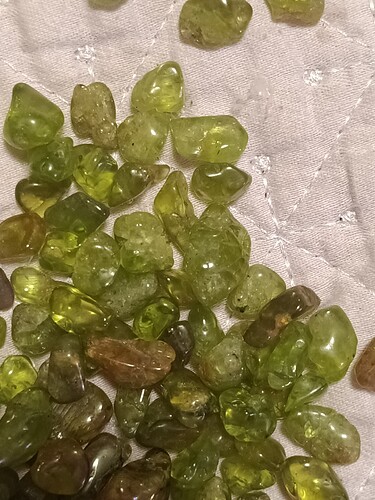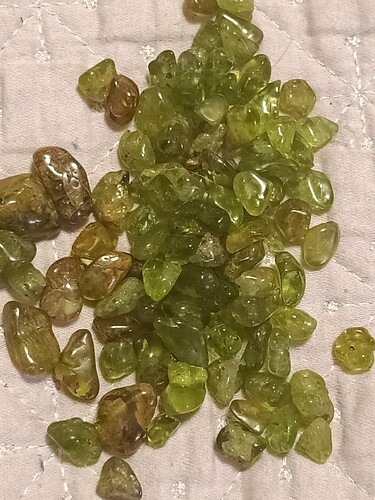Please help me identify this beautiful green gem and why so many different colors…I’m thinking peridot but the reddish brown has me thrown off
IT DEFERENTIALLY LOOKS LIKE PERIDOT TO ME. I think that the more brown gems are also Peridot as-well just a lower graded Gem, I have seen stone with brown tones but they are generally lower grade.
I have to concur with 02, little peridot pebbles tumbled.
If you have a loop, can you see little inclusions that look like Lilly pads? If so, most likely peridot.
From my experience seams peridot from Pakistan
. Please read the IR od DR Peridot
stone 1,65- 1.69 and SG= 3,32-3,37 BR=0.036.
The different colour of single gem is due of percent of the to different Fe and MG present,
FGA dr. Piero Manuelli
Peridots are olivines. Olvines are in solid solutions with an iron end member Fayalite which is 90% Fe and Fosterite which is 90% Mg. Iron weighted peridots will be darker and more brown, while Fosteritic stones are gemmy green…the compositional range gives individual names, as does the plagioclase series, but these names are not used commonly anymore, eg. Hortonolite is 30-50% iron over totalo rionand magnesium…Pakistani sourced peridots contain characteristic inclusions of Fe/Mg borosilicate that form acicular black microcystals within the stone… these inclusions are also on an iron/magnesium solid solutions series with Ludwigite/Vonsenite being the magnesian and iron end members of the series. These inclusion also characterize those from Afghanistan that are found on the Afgan side of the border… some sources mistakenly call them rutile, which is titanium oxide. Titanium is present in trace amounts in the crystal structure of these minerals as substitution for iron,
The area geology is ultramafic…basaltic cumulates on top of dunite and other hypabyssal ultramafic rocks… there are are number of ophiolites in both countries where ultramafic rocks were obducted to the surface during the ongoing collision of the Indian plate into Asian… the Himalayas and tthe trans himalaya mountain belt being the consequence. The icorporation of boron into peridot is unusual. Hawaiian and other tholeliitic basalt lavas contain olivine phenocrysts but very little in terms of trace elements. The San Carlos lavas are basanitic and have an alkali basalt composition that is deficient in silica…inclusions include chromite and chromian spinel, the latter indicating a deep origin of the basalts relative to thoeliites…alkali basalts are enriched in alkalis and incompatible trace elements relative to tholeiites. Metasomatic processes would have to be invoked for the presence of boron and other incompatibles, unless the parental magma is alkalic basalt or it’s unsaturated relatives including basanites and nephelinites. Nickel substitutes for iron in both types of basalts and does not form inclusions… Nickle/iron ratios are important in geochemistry as indicative of source rock melting.
Since you have a lot of them to can start by scratch testing and specific gravity to begin identifying them, as these methods don’t require much in equipment at all.
Most likely Peridot, the only other stone i can recall at this moment that they look like are yellow beryl. But I wiuld be more inclined to believe they are peridot.
Lily pad are radial micro stress fractures around an inclusion. The type of inclusion itself, eg. chromite, borosilicate can tell you the provenance of a peridot. The presence of boron would indicate that the stone is of metamorphic origin. Primary mafic and ultramafic rocks are strongly deficient in boron. Boron, large ion lithophile elements, light elements, lanthanides and actinides are incompatibles in the mantle and mafic rocks… they only occur as trace elements… instead, they are concentrated in continental crust and especially pegmatites that are the last rocks to crystalize out of a felsic melt.
It is possible they are Olivine/Peridot from St, John’s Island (Zabargad) off the Red Sea coast of southern Egypt - (Olivine or Osmium, I’m not sure if there of those are the same thing). Like Afghanistan, that region has a lot of the stuff; the island is a geological freak of nature (i hope that’s ok to say, i meant it to be a bit funny but also descriptive, since it’s truly a unique place, geologically). It’s worth reading about if you don’t know it. I’ve seen some of these colors in various beads and gemstones from there.
I’d bet on Peridot
Peridot has different tones
Green and yellow tones, including olive, yellow, honey, red, and a brownish green.

